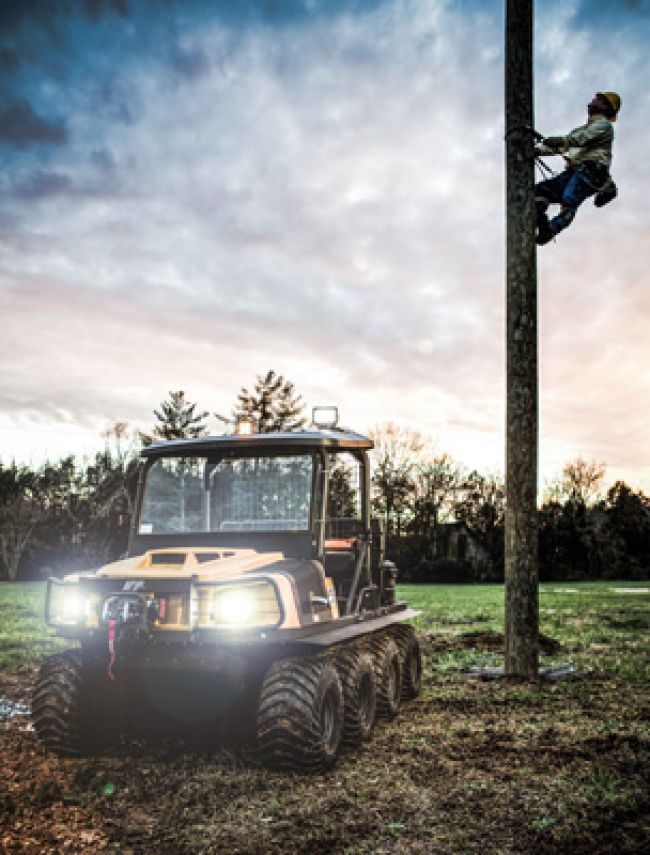
What’s New in All-Terrain Vehicles for the Utility Market
When it comes to all-terrain utility vehicles (UVs), there’s a wide range of capabilities available on the market. Some models are designed to haul people and heavy equipment over rugged, hilly terrain. Others are built to hover over swamplands or float and power across waterways in remote areas. And then there are lighter-duty UVs that handle both on- and off-road conditions at higher speeds.
So, what’s new in the UV market to help get utility crews, supplies and heavy equipment across various terrains with maximum efficiency and safety? Here are five developments to watch.
New Model: ARGO Conquest 8×8 Lineman XTi
http://argoutv.com/lineman
In July, ARGO unveiled its new Lineman model built specifically for utility workers. Whether the job is replacing utility poles, mending cables or laying underground pipe, the ARGO Lineman includes several custom enhancements to provide the optimal power, payload capacity, versatility and safety that best fit most utility applications.
With a payload capacity up to 1,340 pounds, the Lineman can haul transformers, pull cables or bore footings across a wide range of terrain, including rocks, hills and sand dunes, to reach the most remote worksites.
The machine is engineered to reduce risk of underbody damage, overheating and hang-ups on obstacles, resulting in less downtime for the vehicle – and for crews.
With add-on attachments ranging from cranes and augers to welding kits and hydraulic power supplies, crews can now bring their tool shop with them anywhere, across the most extreme terrains.
New Model: Terramac RT14R 360-Degree Rotating Carrier
www.terramac.com/rt14r-crawler-carrier
In April, Terramac – a manufacturer of rubber track crawler carriers – introduced the RT14R, a rotating crawler carrier.
Built with a heavy-duty upper frame that rotates a full 360 degrees, the Terramac RT14R crawler carrier hauls and dumps up to 28,000 pounds of material at any position, even while driving. The 360-degree rotation capability allows the RT14R to offload materials faster than a standard straight-frame unit because the machine’s tracks don’t need to be counter-rotated to drive another direction.
The RT14R uses Terramac’s rubber track technology, giving the machine a minimal ground pressure of 7.9 psi while fully loaded so that it can safely navigate extreme conditions and mountainous terrain where wheeled machines are likely to create ruts and get stuck.
Terramac’s RT14R also enhances job site safety by eliminating the amount of time an operator spends reversing a unit, and by offering better ergonomics and visibility with upgraded features, such as a wide-access door for easy entry and exit, windows on all sides and a large mirror for increased visibility.
New Model: PowerTraxx RT8
www.powertraxx.com
PowerTraxx recently introduced a new line of continuous rubber tracked vehicles: the PowerTraxx RT (Rubber Track) series. The first model that’s available now is the RT8, based on the PowerTraxx 08-H chassis, and the company said the other models in the series – the RT5, RT10 and RT15 – are in development.
The RT8 offers a payload capacity of 20,000 pounds and is designed for mounting heavy equipment, including digger derricks and aerial devices, with a light footprint to minimize impact on environmentally sensitive terrain.
The company said that operators can expect the same features and comforts on an RT series vehicle that current users have become accustomed to on a D-dent (steel-track) PowerTraxx vehicle.
For the rubber track itself, PowerTraxx elected to use the Morooka MST 3000 rubber track, which is 32 inches wide. The rubber tracks combine the characteristics of a tire-equipped vehicle, such as speed and smooth ride, while providing the traction of a steel track.
The MST 3000 track has not been modified in any way to fit the RT8, which means that current Morooka users can stock one replacement track that will fit both vehicles in the PowerTraxx RT series and their existing Morooka-tracked fleet vehicles.
New Updates: Polaris GEM eM1400
www.polaris.com/en-us/gem-electric-car/em1400
In the past year, Polaris Industries Inc. announced updates to extend battery range and enhance driver comfort and ergonomics for its line of GEM electric UVs, including the eM1400 model, designed for lighter-duty, yet higher-speed applications, with the versatility to travel indoors, outdoors, on streets, on sidewalks or off-road – with zero emissions and lower operational costs than comparable fuel-powered machines.
The all-electric eM1400 offers payload and towing capacities of 1,400 pounds and 1,250 pounds, respectively, with a top speed of 19 mph and range up to 45 miles, depending on temperature, terrain, payload and driving style.
And the eM1400 features a durable aluminum chassis that passes SAE roof-crush-test standards; front-wheel disc brakes; an automotive-style suspension; and premium safety features that include high-back forward-facing seats, three-point seat belts and an automotive glass windshield.
New Upgrades and Options: Hydratrek D2488B
www.hydratrek.com/d2488b.html
The amphibious Hydratrek D2488B is built for navigating steep slopes, trudging through heavy brush, traveling over snow or sand, hovering over swamplands, and even floating and powering across creeks and rivers, with a towing capacity of 8,000 pounds and payload capacities of 3,000 pounds on land and 1,400 pounds in water.
The rear cargo bed can be used for either material handling or carrying personnel. And current options include front- or rear-mounted electric or hydraulic winch; seating for nine adults; powder-coat paint; saltwater kit; closed cab system; tie-down points; backup alarm; rear cargo rack; spine board; mounting hardware; emergency lighting; and quick-connect hydraulics.
The company said that for 2016 and 2017, new upgrades and options for this model include an available front-mounted brush cutter; rear anchor setter system; four-blade propellers for improved water performance; HIPPO Multipower generation system; larger pontoons for increased flotation; and suspension-style seating for the operator’s cab.
Photo: ARGO

